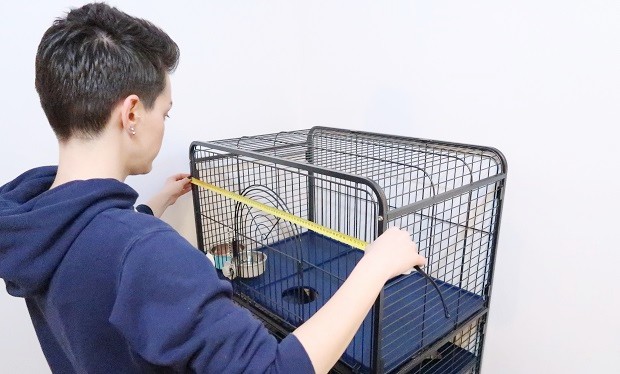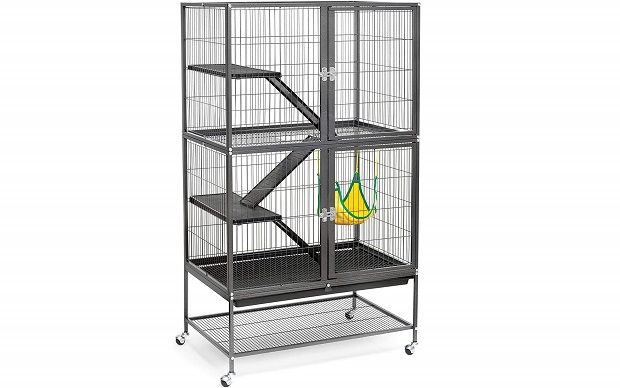Do you know what is the best cage for a ferret?
What do you need to know before you pick a cage for ferrets?
Everything you need to know about a ferret cage before you buy one you can find here. Do ferrets need cages, why should you put your ferrets in the cage, and what should be in a ferret cage are only a few I covered in this post. So, let’s start and make sure you choose the best ferret cage!
TABLE OF CONTENTS
Do Ferrets Need Cages?
Yes, ferrets need cages, they need a place in your home they can call home. A cage is a good option because then you have everything they need in one place. They use cages for eating, sleeping, playing, and a place to use a litterbox. When you give your ferret a cage, he will relax there and connect that feeling with the cage.

After that, every time he will need an escape from some stressful situation, he will go into the cage. Another reason to put ferrets in a cage is their safety. Ferrets are curious animals and they love getting into trouble. That is why ferrets should always be supervised. When you can’t be around them it is smart to put them in a cage to avoid any accidents.
How Long Should Ferrets Be In Cage?
Ferrets should be in the cage almost the entire time they are asleep. That is around 16-18 hours a day, which gives them around 6 hours a day reserved for playing and roaming around. The minimum time a ferret should spend out of the cage is around 4 hours.

It is good to separate those hours during the day. That means you can let your ferret out of the cage for a couple of hours during the morning and evening. Those are the times when ferrets are active the most.
When Should Ferrets Stay In Cage?
There are a few situations when it is better for a ferret to stay in the cage. Some of them are only a few minutes long while other last much longer, even hours. But, since ferrets sleep more than 16 hours a day, that is not a problem in any way.
You Can’t Supervise Them
As I have already mentioned, ferrets should be in a cage when you can’t supervise them. That means you mustn’t leave your ferrets out of the cage if you aren’t home. Leaving them in a place you haven’t ferret-proofed even for a couple of minutes can result in chaos.

If you leave your ferret out of the cage and go take a shower you will be gone for at least 10 minutes. In those 10 minutes, your ferret can tangle into something, scream for help but you won’t be able to hear him so you can rescue him.
During Night
Leaving ferrets in the cage during the night is the smartest thing you can do for several reasons. You won’t wake up in the middle of the night by a loud noise of a thing your ferrets knocked down from the shelf to the floor.

You won’t accidentally step on your ferret in the morning if he decided to take a nap on the bag or your old shirt that lays on the floor. That is an accident with possibly fatal consequences for ferrets and it happened to some ferret owners.
When You Air Out Your Home
Airing out of your home lasts 10-15 minutes and during that time you will open almost every window you have at home. That means you can’t keep an eye on every window there is and if a ferret climbs up on the window, he might fall.

You will be at peace if a ferret is safe in the cage and he will probably sleep in the cage, won’t even notice what is happening.
When You Have Guests
Not every person loves animals, let alone ferrets. If you don’t want to make your guests scream, sit on your ferret, or get bitten by a ferret, leave him in the cage at the beginning. During the visit, you can let your ferrets out and slowly introduce them to your guests.
If your friends know about your ferrets and love them, then you can easily let them out when your friends enter your home. Don’t let them out when your friends are standing in the doorway. You don’t want your ferret to escape through the main door.
Many Other Situations
If you decide to deep clean your home with chemicals, place the ferrets in the cage. If you decide to move the couch from one spot to the other, again, placce the ferrets in the cage.
Ferrets don’t know about danger or fear, they are too curious for that. One moment is enough for an accident to happen.
Put them in the cage in every situation where you know they can get in the way and you don’t want to hurt them. Those are special situations that happen a couple of times a year, but they are more than enough reason to keep ferrets in cages.
How Many Ferrets Do You Want?
It doesn’t matter whether you plan on having one or multiple ferrets, choosing a cage comes with the same criteria. The only difference is that owning more ferrets will result in the need for a bigger cage.

You can put all ferrets in one huge ferret cage or you can get two large cages and mix the ferrets up. There is always ferrets who get along better with one group than with other in multiple ferrets household. You can use their relationship to separate them into two cages.
How To Pick The Best Ferret Cage?
There are a few things you need to consider when buying the best cage for ferrets. Most things are connected to the construction, while the interior of the cage is also pretty important.
Minimal Ferret Cage Dimensions
If you are planning to get one or two ferrets, then the minimal measures for your cage are about 90 cm wide, 60 cm deep, and 60 cm high. That is 3 feet wide, 2 feet deep, and 2 feet high in the imperial system. If you want more ferrets, you should go with bigger cages and they must have levels.

Great options are multi-level cages because they give your ferrets more room and you can separate a toilet from the place for sleeping and the place for eating. A ferret should have enough room to play in the cage as much as he needs room to sleep or to eat.
Good Ferret Cage Construction
I should highlight that glass tanks aren’t good options for ferrets, neither are fiberglass cages nor wooden cages.
Cages made completely of glass or fiberglass provide zero ventilation and they are not an option for any furry pet, especially ferrets during summer. Ferrets are prone to heatstrokes and holding them in a glass tank on a hot summer day will lead to that in minutes.

Wooden cages are not an option for ferrets because they can destroy them especially if you have a stubborn ferret who wants to dig out of the cage. By digging on the wooden floor they can damage the wood, damage their paws and they can even eat wooden pieces that can cause obstruction.
The best material to use for a ferret cage is a combination of plastic and wire. Wires are durable, easy to clean and provide good ventilation in the cage.
Plastic Floor, Ramp, And Platform
The ferret cage ramps, floor, and platforms are part of the cage which should be plastic. If you buy a wire ferret cage with a wired floor, platforms, and ramps, you are risking your ferret’s paws. Your ferret can get stuck in the mesh on the floor. He can start to panic, try to break free and hurt his paw, even pull out his nail. That is why those parts should be plastic, so you can avoid any holes in the floor.

There is one additional advantage when it comes to solid plastic ramps and floors. They are much easier to clean than wires on the floor. You can simply wipe the plastic with a safe cleaning solution and you are done.
Space Between The Bars
Wire cages are made of bars and those bars shouldn’t be too far apart. Ferrets are flexible and can fit through narrow holes. That is why the space on the walls should be about 1,5 cm to 2,50 cm wide, not more. That is around 1 inch in the imperial system.

Ferrets don’t see bars that are 1,50 to 2,50 cm apart as the possible escaping route. If the wires are further apart your ferret can get an idea to escape through the gap. That can lead to another injury if a ferret gets stuck between the bars.
Good Quality Doors And Lock
Multi-level ferret cages come with multiple doors. It is a good idea to pick a cage with big doors so you can easily clean the cage from the inside. Those doors have to be big enough for you to reach every corner of the cage without trouble. Also, make sure you can take out everything from hammocks to litter boxes through those doors. Avoid cages with small doors so you can’t even put your hand inside.

Doors are another place where a ferret can escape. If they notice a small opening on the doors, they will try to open them more and eventually get out. That is why it is important to check out the doors and the lock on them.
If you have a chance, try to open the doors from the inside (if there are more doors, which is a better solution) to see how hard is for them to open the cage. The doors should stay in place no matter what you do. So, if you can move the doors and make a hole at least an inch wide, those doors aren’t good for your ferret.
Cage Transportation
Owning a good quality cage means the cage is big with solid construction so it will be heavy. That is why most good-quality cages come with wheels, to make transportation easier.

If you want to make your life easier, grab the cage with wheels because you won’t have to pick up the cage to move it for cleaning behind it. But, make sure the wheels come with brakes, you have to secure the cage in one place no matter how straight your floors are.
Where Should You Put The Ferret Cage?
Now that you know what to look for in the ferret cage, think about the place you want it to be. Consider these notes below so you don’t have to move the cage around to find the perfect spot.
Measure The Spot
Before you decide on the best ferret cage, make sure it fits in your home. Measure the spot you reserved for the cage and compare it to the dimensions of the cage. Make sure you can open the doors of the cage and make sure your ferret can’t climb on the cage.

That means you should put the cage away from other furniture and it should be away from the walls. Yoda used to climb the cage by pressing the back to the wall and climb up the bars. Yoda climbed down the same way a few times and my heart stopped each time.
Away From The Light
Ferrets sleep more than 16 hours a day so their cage should be away from direct light. That doesn’t mean they should be in complete darkness, but away from desk lamps, windows, and other bright light sources.

Keep the cage covered at all times. It will give your ferret peace for sleeping and it won’t disturb his natural winter-summer sleep cycles that can lead to health problems.
Away From Noises
Keep the cage away from television, sound systems, soundbars, and other technology that produces a loud noise. Too loud noise can keep the ferret awake and cause him unnecessary stress. Just like in the paragraph before, that doesn’t mean a ferret should be in a silent environment. He is used to usual noises, just don’t place the cage next to the speakers.
What Is The Best Cage For A Ferret?
The best cage for ferrets should have:
- Dimensions 3 feet wide, 2 feet deep, and 2 feet high minimum
- Minimal dimensions: 90 cm width x 60 cm depth x 60 cm height
- Wire construction with a 1-inch gap or less
- Sold plastic ferret cage ramps, and platforms
- Wheels for easier transportation with brakes
- Solid door with lock
- Big doors for easier cleaning
Best Ferret Cages – Our Recommendation
Ferret Nation Cage by Midwest Deluxe Critter Nation

Advantages:
- 36 x 24 x 63 inches
- Wire construction with a 1-inch gap or less
- Sold plastic floor, ramps, and platforms
- Wheels for easier transportation with brakes
- Solid door with lock
- Big doors for easier cleaning
- Has its own accessories
Disadvantages:
- High price
- Long assembly
- Doors aren’t perfectly aligned with the cage
Black Feisty Ferret Cage by Prevue Hendryx

Advantages:
- 31 x 20 x 54 inches
- Wire construction with a 1-inch gap or less
- Sold plastic ramps, and platforms
- Wheels for easier transportation
- Big doors for easier cleaning
- Solid door with lock
- Cheaper price
Disadvantages:
- No brakes
- Wire on the floor, but you can cover the wire floor
- Slightly flimsy
DISCLAIMER: These are our recommendations, we aren’t part of the Amazon Affiliate program. We don’t receive any compensation if you click on the link or buy this product.
What Should Be In A Ferret Cage?
Now that we’ve talked about the best ferret cage from the outside, let’s talk about the interior. A ferret cage should be big enough to provide everything one ferret needs for living. That means your ferret should be able to sleep, eat, drink, play, poop and pee in the cage.

With that in mind fill the cage with water and food bowls, a litter box, multiple hammocks, and toys. Separate the space for sleeping, eating, pooping, and playing to avoid contaminating bowls, toys, and hammocks. How to organize all those things in the cage, find out in my Setting up a ferret cage post.
What bowls to use you can read my post about food and water bowls.
What toys to use read in my post about ferret-safe toys.
What hammocks to use read in my post about ferret hammocks.
FAQ
Do Ferrets Need A Big Cage?
Yes, ferrets need a big cage. A good size cage for a ferret has minimal dimensions 3 feet wide, 2 feet deep, and 2 feet high. That is 90 cm wide, 60 cm deep, and 60 cm high in the metric system.
How Much Does A Cage Cost For A Ferret?
A good quality ferret cage isn’t cheap. The average price for that type of cage is around a hundred dollars or more. This might be a high price but if you consider the fact that a good quality cage will last you for years, you have to look at it as an investment. Generally speaking, you will lose more money if you buy more cheap cages for a couple of years than one durable model. Ferrets should be out of their cage for at least 4 hours a day. Let them out around 2 hours in the morning and 2 in the evening.
Conclusion
You can easily pick a good ferret cage if you follow the notes I gave above. Keep in mind that high-quality cages cost but they will last you a long time and they are worth every penny. Make sure your ferret is safe when you can’t watch him in the best ferret cage.


















Hi Anja, Frida and Yoda, here in Germany the cage for a ferret must have a minimum size of 2 square meters at the base for one ferret. That meens 4 square meters for two fuzzys. Buying such a cage is impossible most times, so you have to build one yourself. Our animal welfare act is very strict in this point. For this reason my fuzzys have a room for themself. I will send you some pictures of their new room in our new home after our moving in summer, if you like.
All the best
Denise
I am looking at a
Getting a couple of Ferrets. But I am looking for some information on them and about them.
Hi Joyce! You can read all you need in my blog and if you have any other questions, please let me know on my email or through contact form.
Hi. i see in this article you’ve used images of the little friends blenheim cage and the extra tall one. are those okay for 2 ferrets? I have one that I currently have one ferret in, he is a rescue and i’m looking to get him a mate so he isn’t lonely. would it be okay for 2 at least until i can upgrade?
Do you have the tall one or smaller one?